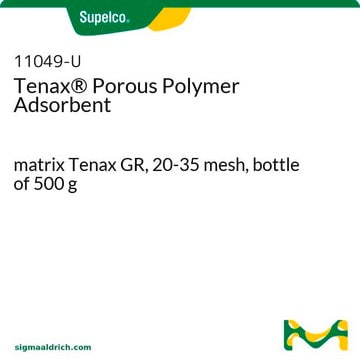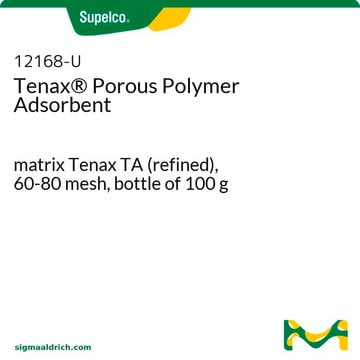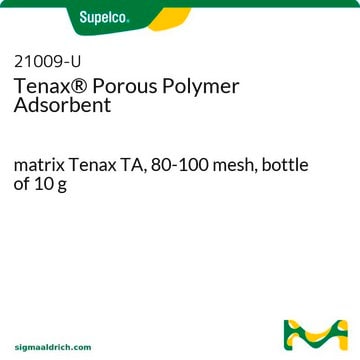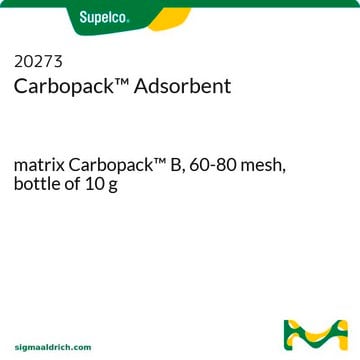Products may be shipped at a different temperature than the recommended long-term storage temperature. If the product quality is sensitive to short-term exposure to conditions other than the recommended long-term storage, it will be shipped on wet or dry-ice. If the product quality is NOT affected by short-term exposure to conditions other than the recommended long-term storage, it will be shipped at ambient temperature. As shipping routes are configured for minimum transit times, shipping at ambient temperature helps control shipping costs for our customers. For more information, please refer to the Storage and Transport Conditions document: https://www.sigmaaldrich.com/deepweb/assets/sigmaaldrich/marketing/global/documents/316/622/storage-transport-conditions-mk.pdf
11982
Adsorbant polymère poreux Tenax®
matrix Tenax TA, 60-80 mesh, bottle of 10g
About This Item
Produits recommandés
Nom du produit
Adsorbant polymère poreux Tenax®, matrix Tenax TA, 60-80 mesh, bottle of 10 g
Agence
suitable for EPA 601
Forme
solid
Conditionnement
bottle of 10 g
Paramètres
350 °C temp. limit
Superficie
~35 m2/g
Matrice
Tenax TA
Taille des particules
60-80 mesh
Densité
~0.25 g/mL (free fall density)
Vous recherchez des produits similaires ? Visite Guide de comparaison des produits
Catégories apparentées
Description générale
Pour en savoir plus sur nos différents adsorbants, rendez-vous sur sigma-aldrich.com/adsorbents
Application
- Composés organiques volatils (COV) dans différents microenvironnements avant leur détermination par désorption thermique rapide et chromatographie en phase gazeuse/spectrométrie de masse (GC-MS)[1]
- Hydrocarbures en C7 à C26 dans des échantillons d'air ambiant[2] et COV dans des échantillons d'air des locaux de travail[3] avant leur analyse par désorption thermique puis chromatographie en phase gazeuse.
Informations légales
Mention d'avertissement
Warning
Mentions de danger
Conseils de prudence
Classification des risques
Eye Irrit. 2 - Skin Irrit. 2 - STOT SE 3
Organes cibles
Respiratory system
Code de la classe de stockage
11 - Combustible Solids
Classe de danger pour l'eau (WGK)
WGK 3
Point d'éclair (°F)
Not applicable
Point d'éclair (°C)
Not applicable
Équipement de protection individuelle
dust mask type N95 (US), Eyeshields, Gloves
Faites votre choix parmi les versions les plus récentes :
Certificats d'analyse (COA)
It looks like we've run into a problem, but you can still download Certificates of Analysis from our Documents section.
Si vous avez besoin d'assistance, veuillez contacter Service Clients
Déjà en possession de ce produit ?
Retrouvez la documentation relative aux produits que vous avez récemment achetés dans la Bibliothèque de documents.
Les clients ont également consulté
Contenu apparenté
This page is intended to make it easier to find the consumables you need based on the analytical method you’re using. Methods included on this page come from the EPA, Standard Methods and ASTM.
-
How is shipping temperature determined? And how is it related to the product storage temperature?
1 answer-
Helpful?
-
-
How can I determine the shelf life / expiration / retest date of this product?
1 answer-
If this product has an expiration or retest date, it will be shown on the Certificate of Analysis (COA, CofA). If there is no retest or expiration date listed on the product's COA, we do not have suitable stability data to determine a shelf life. For these products, the only date on the COA will be the release date; a retest, expiration, or use-by-date will not be displayed.
For all products, we recommend handling per defined conditions as printed in our product literature and website product descriptions. We recommend that products should be routinely inspected by customers to ensure they perform as expected.
For products without retest or expiration dates, our standard warranty of 1 year from the date of shipment is applicable.
For more information, please refer to the Product Dating Information document: https://www.sigmaaldrich.com/deepweb/assets/sigmaaldrich/marketing/global/documents/449/386/product-dating-information-mk.pdfHelpful?
-
-
Can tenax be restored in laboratory oven at 40 *C temperature?
1 answer-
The Tenax® Porous Polymer Adsorbent can be regenerated by hot-methanol extraction.
Helpful?
-
-
What is the Department of Transportation shipping information for this product?
1 answer-
Transportation information can be found in Section 14 of the product's (M)SDS.To access the shipping information for this material, use the link on the product detail page for the product.
Helpful?
-
-
What solvents can be used for chemical desorption for Product No. 11982, Tenax TA 60-80 mesh?
1 answer-
Common solvents like alcohols, ethers, hydrocarbons, and aqueous hydrochloric acid/sodium hydroxide can be used. Don't use chlorinated hydrocarbons like dichloromethane, aromatics like xylene and carbon disulfide. All other solvents not mentioned can be used after checking solubility.
Helpful?
-
Active Filters
Notre équipe de scientifiques dispose d'une expérience dans tous les secteurs de la recherche, notamment en sciences de la vie, science des matériaux, synthèse chimique, chromatographie, analyse et dans de nombreux autres domaines..
Contacter notre Service technique











